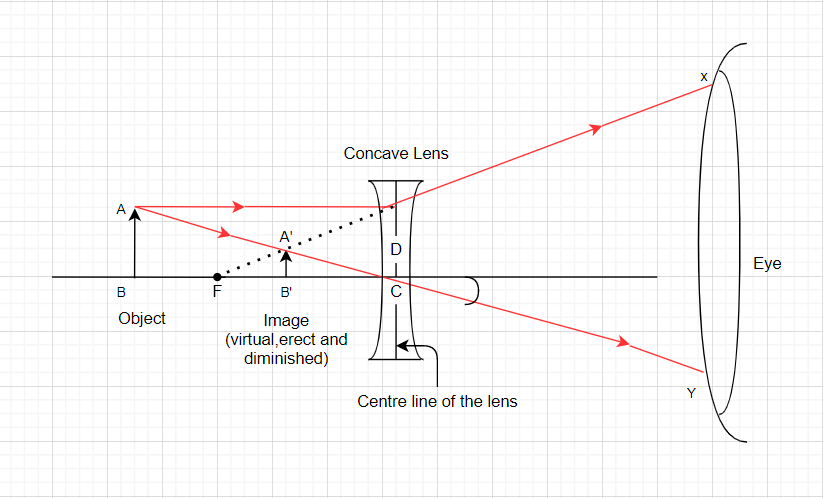
(a) Construct ray diagrams to illustrate the formation of a virtual image using (i) a converging lens, and (ii) a diverging lens.
(b) What is the difference between the two images formed above?
Answer
407.1k+ views
Hint: A ray diagram is a representation of the possible paths light can take to get from one place to another that is often from a source or object to an observer or screen. Light travels in straight lines within a uniform medium this means that light can change direction upon entering a different medium. Also, light has a direction of travel, it is often useful to indicate this with an arrow on your ray.
Complete step-by-step solution:
(a) (i) Diagram for the formation of a virtual image using a converging lens that is convex lens is shown below:

(ii) Diagram for the formation of a virtual image using a diverging lens or concave lens is shown below:
b) The difference between the two images formed above is quite clearly visible to you that both of them have virtual as well as erect image formation. But having one difference is that, in the case of the convex lens, the image formation is magnified while, in the case of a concave lens, the image formation is smaller i.e., diminished in size. While, both of them are virtual and erect in nature.
Note: Draw the ray diagram neatly and cleanly as well as mark the rays carefully because a single small mistake can change the direction as well as the position of the image. Also, not cram the details for image formation but try to learn the details by practicing ray diagrams.
Complete step-by-step solution:
(a) (i) Diagram for the formation of a virtual image using a converging lens that is convex lens is shown below:

(ii) Diagram for the formation of a virtual image using a diverging lens or concave lens is shown below:
b) The difference between the two images formed above is quite clearly visible to you that both of them have virtual as well as erect image formation. But having one difference is that, in the case of the convex lens, the image formation is magnified while, in the case of a concave lens, the image formation is smaller i.e., diminished in size. While, both of them are virtual and erect in nature.
Note: Draw the ray diagram neatly and cleanly as well as mark the rays carefully because a single small mistake can change the direction as well as the position of the image. Also, not cram the details for image formation but try to learn the details by practicing ray diagrams.
Recently Updated Pages
Master Class 12 Economics: Engaging Questions & Answers for Success

Master Class 12 Maths: Engaging Questions & Answers for Success

Master Class 12 Biology: Engaging Questions & Answers for Success

Master Class 12 Physics: Engaging Questions & Answers for Success

Master Class 12 Business Studies: Engaging Questions & Answers for Success

Master Class 12 English: Engaging Questions & Answers for Success

Trending doubts
Which are the Top 10 Largest Countries of the World?

Differentiate between homogeneous and heterogeneous class 12 chemistry CBSE

Draw a labelled sketch of the human eye class 12 physics CBSE

What is a transformer Explain the principle construction class 12 physics CBSE

What are the major means of transport Explain each class 12 social science CBSE

What is the Full Form of PVC, PET, HDPE, LDPE, PP and PS ?




